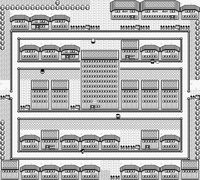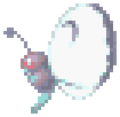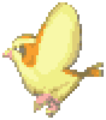Saffron City
| Kanto: Saffron City | |
|---|---|
 Saffron City in Super Smash Bros. Ultimate 
| |
| Universe | Pokémon |
| Appears in | SSB Ultimate |
| Availability | Starter |
| Tracks available | In SSB: Track #12 |
| Article on Bulbapedia | Saffron City |
| “ | Wild Pokémon appear in the middle of the city to attack the fighters. It's best just to stay out of their way. | ” |
| —Super Smash Bros's instruction manual | ||
Saffron City (ヤマブキシティ, Yamabuki City) is a playable stage in Super Smash Bros. and Super Smash Bros. Ultimate. The stage is named after a city in the Pokémon series.
Layout and Pokémon
Saffron City has one main platform attached to a small platform above a door. To the right is a narrow platform and to the left are two elevators (moving platforms). Between these and slightly lower than the other platforms is yet another narrow platform. There are many gaps in-between that character and items can fall into. It is this feature, as well as the fact that it is a stage upon the tops of tall buildings, that makes it similar to the Fourside stage in Super Smash Bros. Melee.
Every now and then, the door of the Silph Co. building opens, and if the door has been open for a while or if a character approaches the door when it is open, one of five Pokémon will emerge from it. These Pokémon are:
- Chansey, a Pokémon that is the easiest to knock out, out of all Pokémon that appear in Saffron City. Unique to this Pokémon is the ability to heal 5% of the character's damage by touching it. Chansey spawns eggs, just like the Poké Ball version. It will not spawn eggs if all items are turned off and/or the Appearance% (item spawn frequency) is set to "None".
- Charmander can be KOd with very strong attacks such as Kirby's Stone, Luigi's Fire Jump Punch, Donkey Kong's fully charged Giant Punch and Captain Falcon's Falcon Punch. Charmander causes 5% damage upon contact, and will sometimes use Flamethrower to shoot Fire Flower-like flames at anyone in its range, each dealing 3% damage. If a character is caught in the flames, there is very little chance of escaping until Charmander goes back inside the building.
- Electrode cannot be KOd by any means. After a short time it explodes, dealing 30% damage and large amounts of knockback, KOing characters with higher damage.
- Porygon cannot be KOd by any means. It lunges out very quickly, dealing 18% damage upon its appearance and 8% damage thereafter.
- Venusaur cannot be KOd by any means. It deals 14% if touched and will sometimes use Razor Leaf to shoot out sharp-edged leaves, each dealing 3% damage.
Flying Pokémon, including Butterfree, Pidgey, and Fearow are occasionally seen flying across the background and may also appear in swarms. Though it is very rare, Moltres sometimes makes its way across the background. Moltres is one of the easiest to spot of these Pokémon, as it is bright orange.
Origin

This stage is loosely based on Saffron City from Pokémon Red and Green (later released as Pokémon Red and Blue outside of Japan). Saffron City is the second largest city in the Kanto region, behind Celadon City, and one of the largest cities in the entire Pokémon universe. The main building in Saffron City, Silph Co., is a major producer of items that benefit Pokémon trainers, such as: Potions, Repels, Technical Machines, and various Poké Balls. In Pokémon Red, Blue, and Yellow, Team Rocket orchestrates a take over of Silph Co. to steal their top-secret project: the Master Ball, which is able to catch any Pokémon without fail, and it is up to the player to stop them. After this has been done, the Saffron Gym becomes accessible. This stage takes place on top of the roof of Silph Co.; however, it's design is different than how it originally appears in the Pokémon games. The other buildings, including the ones in the background, do not bear resemblance to any building in Saffron City.
Tournament legality
This stage is commonly banned in both Japanese and American tournaments due to its overly large size promoting excessive camping, and the random Pokémon hazards disrupting gameplay. Ness' recovery also suffers here; it is impossible to recover using PK Thunder between the buildings should he fall in.
Gallery
- Porygon.gif
Porygon as a stage hazard.
- Chansey64.gif
Chansey as a stage hazard.
- Charmander64.gif
Charmander as a stage hazard.
- Electrode2 copy.jpg
Electrode as a stage hazard.
- Venusaur64.gif
Venusaur as a stage hazard.
Trivia
- If the door to Silph Co. is open, Captain Falcon (with a running jump) Falcon Punching the top of the door frame can travel through the building to the space left of the helipad. This flashy glitch can be used to confuse and catch opponents off-guard, though the stage's ban in the competitive setting prevents this from seeing any use in tournaments, similar to the Hyrule Jump.
- Saffron City's layout can easily confuse CPU characters, due to difficulties in properly judging walls and ditches. Standing on the helipad can often result in CPU opponents SDing as they attempt to pursue the player.
- In the Japanese version of the game, the Silph Co. logo is spelled as "Silf Co." and the banner in the background reads "Got a catch 'em all!" instead of "Gotta catch 'em all!". These were changed for the international versions.
- In the Japanese version of Ultimate, the logo now says 'Sylph' and the banner is the same as the international version.
- Aside from Charmander and Porygon, the stage hazards would eventually become Poké Ball Pokémon in later Smash installments.
- Chansey is the only stage hazard to also be a Poké Ball Pokémon in Smash 64.
- This stage and Mushroom Kingdom share the longest gap between appearances in the Super Smash Bros. series, with nearly twenty years between Smash 64 and Ultimate.
| Stages in Super Smash Bros. | |
|---|---|
| Starter stages | Congo Jungle · Dream Land · Hyrule Castle · Peach's Castle · Planet Zebes · Saffron City · Sector Z · Yoshi's Island |
| Unlockable stage | Mushroom Kingdom |





